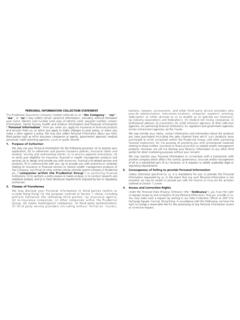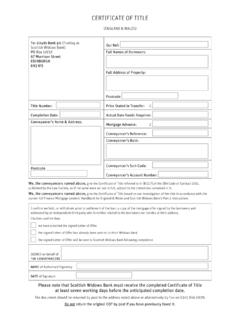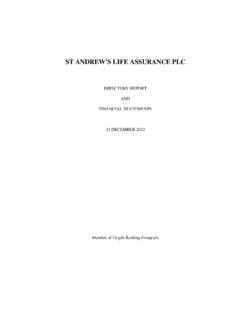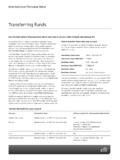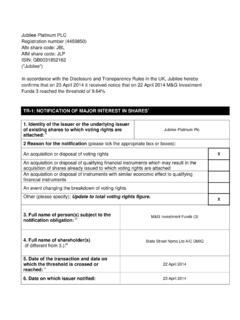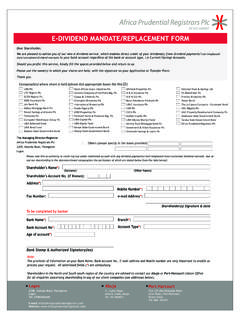Transcription of THE MACRO-PRUDENTIAL AUTHORITY: POWERS, …
1 OECD Journal: Financial Market Trends Volume 2011 Issue 2. OECD 2011. THE MACRO-PRUDENTIAL authority : POWERS, SCOPE AND. accountability . by Charles Goodhart*. Abstract Neither the achievement of price stability, via the MPC, nor the application of micro- prudential oversight, via the Financial Services authority (FSA), led to overall financial stability. There is a gap that needs to be filled by a MACRO-PRUDENTIAL authority (M-PA), the Financial Policy Committee (FPC) in the United Kingdom. The only MACRO-PRUDENTIAL instrument used heretofore has been the publication of Financial Stability Reviews (FSR). While worthy, these have been ineffective. The M-PA should have the following powers: First, the power to alter the composition of Central Bank (CB) assets, by adding to (subtracting from) its holdings of claims on the private sector.
2 The argument that such actions are quasi-fiscal', and should therefore not be undertaken, is not supported. Second, the power to adjust margins (Capital adequacy ratios, liquidity ratios, loan-to-value ratios, etc.) to influence the conduct of financial intermediation. The argument that the use of such powers puts the FPC in a difficult conflict with the Monetary Policy Committee (MPC) is not supported. Third, the power to propose (to the legislature) fiscal and structural amendments affecting financial intermediaries, and the duty to comment on such proposals emanating from other sources. The M-PA should not be involved in the resolution of financial intermediaries, however. As regards institutional design, because the provision of liquidity is simultaneously a key Central Bank function and an integral component of crisis prevention, the M-PA has to come under the aegis of the CB.
3 Whether the micro- prudential authority (the FSA) is also brought under the overall control of the CB (that would include the M-PA), or remains independent, will remain a matter of national preference and history, with arguments on either side. The more complicated question relates to where to place the regulation of financial markets. It should not be placed with the conduct of business regulator, as now proposed for the UK. Procedures for crisis prevention and crisis resolution should be separated. Crisis prevention should be undertaken by the CB (that would include the M-PA) in an operationally independent manner, for exactly the same reasons as an MPC is independent. Crisis resolution involves the allocation of losses and should be the responsibility of the Treasury.
4 The problem is how to make FPC. accountable for its crisis prevention responsibilities. We advocate the adoption of a set of presumptive indicators', which, when triggered, require the FPC either to comply with remedial action, or to explain, in public, why there is no need to do so. JEL Classification: E42, E50, E58, G28. Keywords: MACRO-PRUDENTIAL supervision, central bank, government policy and regulation, financial crisis prevention and resolution. *. Charles Goodhart is a professor emeritus of banking and finance at the London School of Economics (LSE). The article was released in October 2011. It is published on the responsibility of the Secretary- General of the OECD. The opinions expressed and arguments employed herein do not necessarily reflect the official views of the Organisation or of the governments of its member countries.
5 THE MACRO-PRUDENTIAL authority : POWERS, SCOPE AND accountability . OECD work on financial-sector guarantees OECD work on financial-sector guarantees has intensified since the 2008 global financial crisis as most policy responses for achieving and maintaining financial stability have consisted of providing new or extended guarantees for the liabilities of financial institutions. But even before this, guarantees were becoming an instrument of first choice to address a number of financial policy objectives, such as protecting consumers and investors and achieving better credit allocations. A number of reports have been prepared that analyse financial-sector guarantees in light of ongoing market developments, incoming data, and discussions within the OECD Committee on Financial Markets.
6 The reports show how the perception of the costs and benefits of financial-sector guarantees has been evolving in reaction to financial market developments, including the outlook for financial stability. The reports are available at Financial safety net interactions;. Deposit insurance;. Funding systemic crisis resolution;. Government-guaranteed bank bonds;. Guarantees to protect consumers and financial stability. As part of that work, the Symposium on Financial crisis management and the use of government guarantees , held at the OECD in Paris on 3 and 4 October 2011, focused on bank failure resolution and crisis management -- in particular, the use of guarantees and the interconnections between banking and sovereign debt. Conclusions from the Symposium are included at the end of this paper.
7 This paper is one of nine prepared for presentation at this Symposium, comprising: Managing crises without guarantees: How do we get there? Costs and benefits of bank bond guarantees;. Sovereign and banking debt interconnections through guarantees;. Impact of banking crises on public finances;. Fault lines in cross-border banking: Lessons from Iceland;. The MACRO-PRUDENTIAL authority : Powers, scope and accountability ;. Effective practises in crisis management;. The Federal Agency for Financial Market Stabilisation in Germany;. The new EU architecture to avert a sovereign debt crisis. 2 OECD JOURNAL: FINANCIAL MARKET TRENDS VOLUME 2011 ISSUE2 OECD 2011. THE MACRO-PRUDENTIAL authority : POWERS, SCOPE AND accountability . 1 Introduction The onset of the financial crisis, which began in the summer of 2007 and is still with us, led to a general realisation that there had been a missing link in the overall structure of financial regulation.
8 Monetary policy had focussed (successfully) on price stability and general macro -economic stability. But this was not enough to ensure financial stability; indeed it might even be inimical to it, as Minsky had warned (1977, 1982, 1986). Micro- prudential regulation, as promulgated internationally by the Basel Committee on Banking Supervision (Goodhart, 2011) and operated nationally by a variety of official organisations, some within and mostly without their national Central Banks, had focussed unduly on the conditions and prospects of the individual financial intermediary, in particular the individual bank. Far too much weight was attached to the achievement and implementation of the Basel II Capital Accord for individual banks (and in the USA for the large investment houses).
9 Particularly in conjunction with the increasing application of mark-to-market accounting, the regulatory apparatus had allowed the financial system as a whole to become dangerously procyclical. Leverage increased in many countries and in many guises, see Figures 1a and 1b. Not only did regulators fail to appreciate the lurking dangers, but so did markets, as illustrated by the decline in major bank CDS rates to their low point in early 2007, see Figure 2. Figure 1a. Household Leverage Ratios (Debt to Income Ratios). Source : Author estimates based on data from the OECD. OECD JOURNAL: FINANCIAL MARKET TRENDS VOLUME 2011 ISSUE2 OECD 2011 3. THE MACRO-PRUDENTIAL authority : POWERS, SCOPE AND accountability . Figure 1b. Bank Leverage Ratios (Total Asset / Capital & Reserves).
10 Sources : US, Germany, Japan data from OECD, Japan 2009 data from World Bank, UK data from World Bank, US. investment banks' (Weighted average of Goldman Sachs, JP Morgan, Morgan Stanley, Lehman Brothers (discontinues at 2008), Merrill Lynch) data from Bloomberg. Figure 2. Average of 5 year CDS prices for 30 major global banks*. (New York Intra-Day Prices). Source : Bloomberg *30 major banks are American Express, BBVA, Banco Santander, JPMorgan, Bank of America, Wells Fargo, Citigroup, BNP Paribas, Societe Generale, Credit Suisse, Commerzbank, Deutsche Bank, Morgan Stanley, UBS, Goldman Sachs, Credit Agricole, HSBC Bank PLC, Barclays, ING, Lloyds TSB, RBS, Nomura, Standard Chartered PLC, Mitsubishi UFJ Financial, Intesa Sanpaolo SpA, Sumitomo Mitsui Banking, Mizuho Corporate Bank Ltd, Royal Bank of Canada, Macquarie Bank Ltd, UniCredit SpA.










